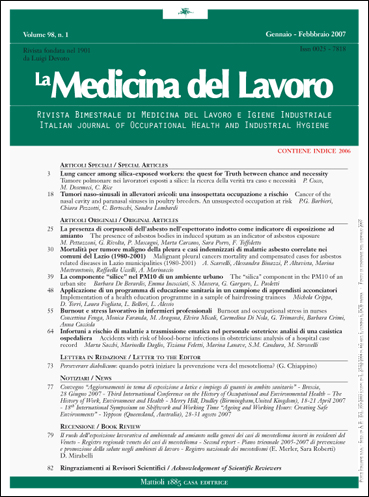Tumori naso-sinusali in allevatori avicoli: una insospettata occupazione a rischio / Cancer of the nasal cavity and paranasal sinuses in poultry breeders. An unsuspected occupation at risk
Contenuto principale dell'articolo
Keywords
Sinonasal cancer, poultry stock-breeder, wood dust, formaldeyde
Abstract
La sorveglianza epidemiologica sui tumori maligni naso-sinusali svolta nell’ambito dell’attività del Registro di popolazione che copre la provincia di Brescia (1.077.000 abitanti) ha permesso di evidenziare due casi diagnosticati in allevatori avicoli. Il significato di evento “sentinella” di questa neoplasia ha suggerito lo svolgimento di indagini per stabilire una possibile esposizione a rischio professionale; ne è risultato che per l’allevamento di polli e tacchini da carne vengono usate lettiere composte tra truciolo, segatura di legno, anche di essenze dure, e lolla di riso. Per la disinfezione dei capannoni viene usata formaldeide, liquida in soluzione acquosa e solida per fumigazione. Il campionamento delle polveri inalabili effettuato in seguito in un allevamento di tacchini ha evidenziato concentrazioni di polveri totali tra 1,3 e 43,2 mg/mc a seconda delle operazioni svolte; nel 25% di questi campionamenti era superato il limite legale di 5 mg/mc, previsto dal D.Lgs. 66/2000, nel 100% il superamento del TLV ACGIH per il 2005. I due casi di tumore naso-sinusale sono stati certificati all’INAIL come professionalmente esposti a polveri di legno. L’importante diffusione di allevamenti avicoli in provincia di Brescia e l’attualità del rischio evidenziato hanno reso opportuna la promozione di iniziative di informazione e di misure di prevenzione tecnica e di protezione personale dei lavoratori. Viene confermata l’utilità della sorveglianza attenta di questi tumori rari come strumento per identificare fonti di rischio poco note o ignorate, agevolando il loro riconoscimento assicurativo e, talvolta, possibili interventi di prevenzione di rischi ancora attuali, come in questo caso.
Cancer of the nasal cavity and paranasal sinuses in poultry breeders. An unsuspected occupation at risk
Background: Wood dust exposure is strongly associated with the induction of cancer of the nasal cavity and paranasal sinuses (NSC), mainly among furniture production workers. Only limited information is available on wood dust exposure in other industrial sectors, including agriculture. NSC’s are defined as “high occupational aetiology fraction” neoplasms, and are therefore indicated as sentinel tumours in occupational medicine.Objectives: The report concerns two cases of NSC that occurred in two poultry breeders and the investigations performed in order to define their occupational exposure. Methods and results: Epidemiological surveillance of NSC within the framework of routine activity of the Cancer Registry of the Province of Brescia (one million inhabitants) identified the two cases. Initially the first NSC case was considered as “probably exposed to formaldehyde” during shed tile disinfecting operations. After discovery of a similar case and further investigation in the sector formaldehyde exposure was found to be at a very low level. However, the observation that hard and soft wood dust was present, followed by dust monitoring, revealed a high level of exposure. The 23 personal and area air samples, performed in a turkey breeding shed, gave concentrations of between 1.3 and 2.3 mg/mc during low dust exposure jobs and concentrations of between 4 and 43.2 mg/mc during litter replacement (100% exceeded the ACGH TLV limit of 1 mg/cm and 25% were even above the legal limits (5 mg/mc according to Italian D.Lgs. 66/2000)). Since breeders are not aware of this type of risk and the use of personal protection is not scrupulous, the local health and safety unit has started an information campaign for the entire work category as regards the necessity of controlling this cancer risk. The two cases of NSC described here were reported to the National Labour Insurance Institute (INAIL) for compensation. Conclusion: NSC epidemiological surveillance performed through a population registry proved to be of great use in the identification of cases among employees in similar sectors, and thus the identification of previously unknown wood dust exposures with consequent implementation of preventive measures.
Cancer of the nasal cavity and paranasal sinuses in poultry breeders. An unsuspected occupation at risk
Background: Wood dust exposure is strongly associated with the induction of cancer of the nasal cavity and paranasal sinuses (NSC), mainly among furniture production workers. Only limited information is available on wood dust exposure in other industrial sectors, including agriculture. NSC’s are defined as “high occupational aetiology fraction” neoplasms, and are therefore indicated as sentinel tumours in occupational medicine.Objectives: The report concerns two cases of NSC that occurred in two poultry breeders and the investigations performed in order to define their occupational exposure. Methods and results: Epidemiological surveillance of NSC within the framework of routine activity of the Cancer Registry of the Province of Brescia (one million inhabitants) identified the two cases. Initially the first NSC case was considered as “probably exposed to formaldehyde” during shed tile disinfecting operations. After discovery of a similar case and further investigation in the sector formaldehyde exposure was found to be at a very low level. However, the observation that hard and soft wood dust was present, followed by dust monitoring, revealed a high level of exposure. The 23 personal and area air samples, performed in a turkey breeding shed, gave concentrations of between 1.3 and 2.3 mg/mc during low dust exposure jobs and concentrations of between 4 and 43.2 mg/mc during litter replacement (100% exceeded the ACGH TLV limit of 1 mg/cm and 25% were even above the legal limits (5 mg/mc according to Italian D.Lgs. 66/2000)). Since breeders are not aware of this type of risk and the use of personal protection is not scrupulous, the local health and safety unit has started an information campaign for the entire work category as regards the necessity of controlling this cancer risk. The two cases of NSC described here were reported to the National Labour Insurance Institute (INAIL) for compensation. Conclusion: NSC epidemiological surveillance performed through a population registry proved to be of great use in the identification of cases among employees in similar sectors, and thus the identification of previously unknown wood dust exposures with consequent implementation of preventive measures.






